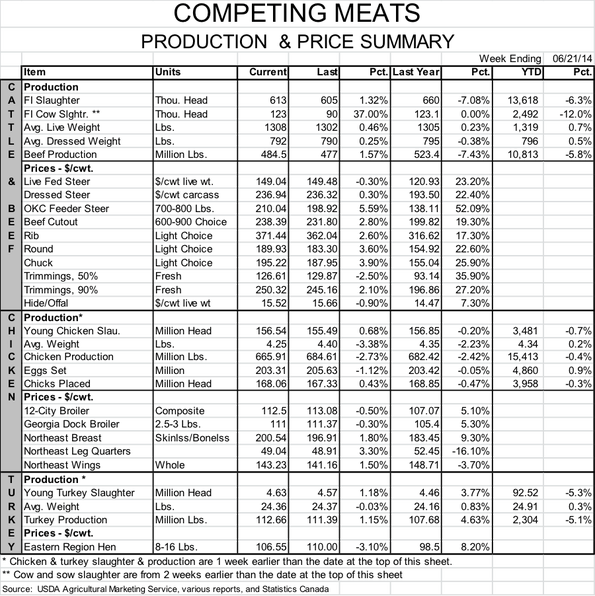Pork Demand is on a Roll
June 23, 2014

It’s not supply. Or at least not completely supply. That would be an apt description of the pork and hog markets of the past two months--and it is not meant to let supply completely off the hook. However, the amount of pork available to consumers is not the only reason we have seen such remarkable prices in 2014.
The other part of the picture, of course, is pork and hog demand, which have been remarkably strong. Figure 1 shows real per capita expenditures (RPCE) for pork by U.S consumers. Real per capita expenditures (RPCE) measure the number of year-2000 dollars that each U.S. consumer spends on pork each month.

Figure 1
We have complete data for that computation only through April (see Figure 1) and those data tell a great story. As can be seen, the April value of $10.78 was 8.7% higher than one year ago, and brought the year-to-date figure to $43.42, 6.1% higher than one year ago. April’s RPCE was also 9% larger than the average RPCE for January through April over the past 5 years. For a bit of further perspective, April’s RPCE for pork was 17.6% larger than the same figure in April 2010. It is clear from Figure 2 that things have been on the upswing since about that time.
And partial data suggest that this strength continued in May when the average retail price of pork, according to USDA’s Economic Research Service, hit a new record, $4.099 per pound. That marks the first time that retail pork has eclipsed the $4.00 per pound mark. This nominal price (ie. the $4.099 is measured in current dollars) is 15.6% higher than one year ago. The real (deflated) May retail pork price is 13% higher than last year.
“But we are just holding consumers up for more money by offering them less pork!” you might protest. But that, at least at this point, is not completely true. Per capita pork disappearance/consumption/availability was sharply lower (-4.5%) in March but has been closer to year-ago levels in all other months so far in 2014. January domestic availability was down only 1% from 2013. February’s available pork supply was UP 1.5% from last year and April’s was down only 1.6%. Official production and export data for May are not yet available, but total production for the five weeks that ended on May 31 was virtually unchanged from last year. Allowing a continuation of the 10% year-on-year export increase we saw in April would put May’s domestic availability down roughly 2% from one year ago. That is hardly a supply shortage large enough to push real prices 13% higher if demand is steady. Thus, I have to conclude that pork demand continues on its recent roll.
Part of that strength is, of course, due to high prices of possible substitutes for pork. Choice beef prices set another record ($5.913 per pound) in May, up 13.1% in nominal terms and 10.8% in real terms from one year ago. Select beef price declined slightly in May but are still up 11.8% in nominal dollars and 9.8% in real dollars from one year ago.
Further, the price competition that we thought was sure to come from the broiler sector has failed to materialize by anything close to the degree we expected. An aging breeder flock and continued production challenges have simply kept the sector from responding to high prices with more output. May’s average retail composite broiler price was even with one year ago. That represents a gain in competitive position for broilers versus both pork and beef but the magnitude of that gain has been smaller than I thought it would be. High soybean meal prices are one reason for this lack of output response since they have held broiler costs higher relative to both pork and beef.

Why the gains for pork demand? I still think it is based upon consumer preferences and would offer the cover story of last week’s Time magazine as proof. The article, entitled “Eat Butter” focused on the widespread evidence that the nutrition and medical communities got it all wrong when they recommended that consumers replace fat with carbohydrates in the 1970s and 1980s. That recognition, along with renewed attention to the need for dietary protein, has driven a resurgence of consumer acceptance of meat, dairy and egg products that I believe is clearly reflected in these demand figures.
Can this last? Much depends on whether this new viewpoint continues, but it appears that it may. Some previous “experts” may have to eat some crow but the evidence – with the most noteworthy being today’s obesity and diabetes rates -- is pretty overwhelming at this point. Concerns over cancer remain, but consumers have notoriously short attention spans. The short-term stories told by mirrors and scales will almost certainly trump any longer-term concerns even if those concerns are real – and with the downfall of the fat scare, there may not be a lot of confidence that the related cancer claims are valid either.


About the Author(s)
You May Also Like





